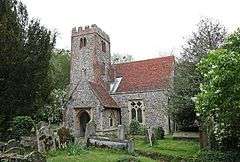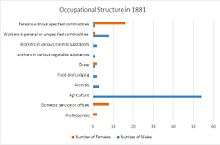Lindsell
| Lindsell | |
 Church of St Mary the Virgin |
|
 Lindsell |
|
| Population | 260 United Kingdom Census 2011 |
|---|---|
| OS grid reference | TL643270 |
| – London | 46 mi (74 km) |
| Civil parish | Lindsell |
| District | Uttlesford |
| Shire county | Essex |
| Region | East |
| Country | England |
| Sovereign state | United Kingdom |
| Post town | CHELMSFORD |
| Postcode district | CM |
| Dialling code | 0131 |
| Police | Essex |
| Fire | Essex |
| Ambulance | East of England |
| EU Parliament | East of England |
Coordinates: 51°55′05″N 0°23′18″E / 51.9180°N 0.3884°E
Lindsell is a village and civil parish in the district of Uttlesford in the county of Essex, England. The church is dedicated to St Mary The Virgin.[1] Other nearby settlements include Holder's Green and Bustard Green.


In 1870, Lindsell was described as a village that stands on a small affluent of the river Chelmer, 3½ miles southeast of Thaxted, and 5 miles north-northeast of Dunmow Railway Station.[2]
According to the 2011 Census, Lindsell had a population of 260 people.[3]

Lindsell also gives its name to a surname.[4] Examples include Augustine Lindsell and Wilfrid Gordon Lindsell.
History
Before becoming classified as a small hamlet, Lindsell had a long history of being an inhabited place (proven by the discovery of Roman bricks in the foundations of St. Mary's church). The name of the village now means "Huts among the lime trees. However it has had other names in the past such as "Templars which was named by John le Templar in 1313 and "Rakefairs" given by Robert Rekeviewer in 1381. Even the current name of the village has had previous spellings in the past such as 'Lyndesele', 'Lindeseles' and 'Lindezel' .[5]
Housing
The number of houses in Lindsell has fluctuated since 1831, peaking in 1851 with 77 houses. The largest drop was in the early 1900s, which is probably due to the fall in population from the Boer War, World War I and World War II. The post-war housing boom after 1945 accounts for the sudden increase in houses from 53 in 1931, to 68 in 1951 and 71 in 1961.[6]

According to the 2011 census, Lindsell has a total of 91 households, 69 of them being detached houses, 19 semi-detached, 1 terrace, 1 apartment and 1 flat.[7] 197 people, the biggest proportion, live in detached houses. 52 people live in semi-detached properties, with 1 person living in a terrace, 8 people living in a flat and an apartment, with a final 2 living in a temporary home.[8] This means there is an average of 2.9 people living in each household, which is higher than the UK national average in 2011 of 2.3 persons per household.[9] 69 out of the 91 households use oil for heating, with 11 using gas, 2 using electric, 1 using a type classed as 'other', and 8 using a combination of oil, gas and electric.[10]
Age structure

There is a significant number of people over retirement age living in Lindsell, there is also a high number of people between the ages of three and twenty one, as well as between 35 and 51[11] This means that the average age of people living in Lindsell is 45, which is far below the retirement age of 65, suggesting that Lindsell does not follow the trend set by many other rural villages across the UK. Out of 260 people only 17 are officially retired, with 73 being employed full-time, part-time, either working for larger corporations, working within the village itself, or being self-employed.[12]
Ethnic groups
The population of Lindsell is predominately white, with 249 out of 260 being listed as 'white with English/Welsh/Scottish/Northern Irish heritage'.[13]
Religion

The church of St. Mary the Virgin is Anglican. 193 out of 260 residents are listed as Christian. Two people are listed as Buddhist, 55 as 'no religion' and ten did not state.[14]
See also
References
- ↑ http://www.achurchnearyou.com/lindsell-st-mary-the-virgin/
- ↑ Wilson, John Marius (1870). Imperial Gazetteer of England and Wales. Edinburgh: A. Fullerton & Co. Retrieved 27 January 2015.
- ↑ "Lindsell (Parish): Key Figures for 2011 Census: Key Statistics". Neighbourhood Statistics. Office for National Statistics. Retrieved 27 January 2015.
- ↑ http://www.surnamedb.com/Surname/lindsell
- ↑ "Lindsell History". www.recordinguttlesfordhistory.org.uk. Retrieved 12 February 2015.
- ↑ "Lindsell AP/CP". Vision of Britain. Retrieved 13 February 2015.
- ↑ "Lindsell accommodation types by household". Office for national statistics. Retrieved 28 March 2015.
- ↑ "Lindsell accommodation type by people". Office for national statistics. Retrieved 28 March 2015.
- ↑ "Population and Household Estimates for the United Kingdom, March 2011". Office for national statistics. Retrieved 28 March 2015.
- ↑ "Central heating by household". Office for national statistics. Retrieved 28 March 2015.
- ↑ "Lindsell Population Age by Single Year". Office for National Statistics. Retrieved 25 April 2015.
- ↑ "Economic Activity of Household Reference Persons in Lindsell". Office for National Statistics. Retrieved 25 April 2015.
- ↑ "Lindsell Ethnic Groups". Office for National Statistics. Retrieved 25 April 2015.
- ↑ "Religion in Lindsell". Office for National Statistics. Retrieved 25 April 2015.
External links
![]() Media related to Lindsell, Essex at Wikimedia Commons
Media related to Lindsell, Essex at Wikimedia Commons
